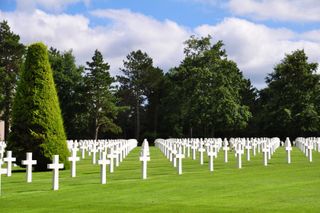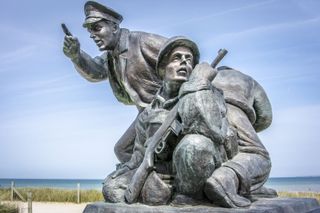This great video on the left was presented at the American Cemetery interpretive Center, unfortunately they have change it. So make sure to watch it
Preface of my book Colors of War
Born in 1962, I am the son of my mother’s and father’s second marriages. (They were each previously married before marrying each other.) Even though my mother’s family was very much divided, both religiously and politically, I was fortunate enough to live close to both sides, and, therefore, could enjoy everyone individually. When I turned eight, I had the opportunity to spend time with Grampa (Albert), and when I turned twelve, I was able to spend a few weeks at a time with him during the summers. These periods were the beginning of my interest in World War I battlefields and the sightseeing trips we made to visit them..
For Grandpa, the only war was the Great War. He had a cousin who farmed near Verdun, and when we visited him, we began reenacting the Marne and Meuse Argonne Battles. Later, with other companions, we spent time on Somme and Flanders Battlefields. That was an invaluable learning experience for me.
My grandmother (Alevtina) was a Russian survivor of the Bolshevik Revolution who immigrated to France during the Great War. She lived through WW II and the German Occupation and told me fabulous stories of her life. Interestingly, the same incidents related by her and then by my grandfather made the same anecdotes seem like different events.
My grandparents separated over religious differences a few years before they died. When Grandpa found out that Grandma had been born a Jew, he was shocked. What he had been upset about was not that she was Jewish but that she had lied to him. He then understood why Grandma never talked about it to neighbors or friends, but her lying to him was inexcusable in his eyes. I personally believe he never would have accepted her Jewishness, even if she had told him in the beginning. He was a very nice but a very stubborn and narrow-minded man. I do remember, however, that Grandpa always referred to Grandma with respect.
Having two uncles who had served in the war, Stan joining an SS Division and Roger joining a U.S. Battalion, made my education very interesting. Added to that is the fact that my mother worked for the British War Grave Commission at the Battle of Normandy. I was steeped in stories of the World Wars.
My mother raised horses with her first son, my oldest brother. Then she married my dad who was living in Paris. He was actually from Peru and had a Spanish father and a Peruvian mother. When he moved to Normandy to work as a physiotherapist, he met my mum. He also had a son, my eldest half-brother.
My own army experience led me to be under U.S. command. Having many officers who were World War II and Korean Veterans was the essence of my knowledge of World War II. Many of these men were my guides when I had the great honor to drive them around Europe.
After that stint in the army when I heard so many stories of the Second World War, I began guiding people on tours of the battlefields and other places of interest concerning that war. I was licensed in 2000 as an official guide and lecturer and have had the opportunity to meet hundreds of veterans. The stories I heard from my family and from the army officers I chauffeured are the foundation of this book. I have supplemented the stories with facts I garnered over twenty years ago when I began conducting the tours and giving lectures. The numbers I have used do not necessarily come from official sources but from a large number of essays, historical television shows, and oral testimony from veterans I have met as I guided them in and around Normandy.
It is a compilation of a thirty-plus year interest in and fascination with military history. The stories I use serve to illustrate the facts, thus allowing the reader to empathize with the reality of war on individual soldiers and civilians. Back then I never thought of writing a book, but this story is too interesting and too enlightening not to tell.
Review: Colors of War: Not Black and White but Nuances of Gray, by Francois Gauthron, Edited by Anita Bryan
Colors of War is a unique book in that it tells two stories, and it tells them well. One is a very personal story of how the lives of everyday people are affected by war; the other is a comprehensive account of parts of WWI ad WWII.
The personal story, poignantly written, involves a young girl who escapes from the Bolsheviks in Russia to go to France. There she marries a French farmer in Normandy, hiding her Jewish heritage. In WW II she has one son who serves with the Allies, one who serves with the Axis, and one who is killed. Her daughter is Gauthron’s mother, but the family history is remembered from his grandmother’s many stories.
The story includes conscription, farming, government, commerce, occupation by foreign armies, the Resistance, attacks (including D-Day), death and widely varying feelings about France, Germany, and Russia. It brings to life the physical and psychological effects of in one’s homeland.
The second story—military history involving parts of the world wars—is also described in great detail. Gauthron apparently knows as much about these wars as anyone, and it shows. The preparation for, execution of, and aftermath of D-Day is as comprehensive as any you will find—a “must read” for any WWII historian.
Although not a military historian, I found this part fascinating. To make the book more readable, however, I would have reduced the military parts somewhat and spelled out or explained more of the abbreviations. It also would have helped to have had a map of France and Europe on hand while reading.
That being said, this book should be required reading for everyone in the armed forces academies and especially those in the War College. The War College is a ten-month graduate-level course, mainly for senior officers to prepare them for strategic leadership. However, they should read it only after a course in the history of WWI and WWII!
As with so many books about war, this one advances its ultimate goal of making the reader realize the atrocities of armed conflict. One concludes that war is to be avoided unless absolutely necessary.
The unique combination of these two stories is mirrored by the unique combination of Gauthron and Bryan. Gauthron has an encyclopedic knowledge of the world wars, having been a tour guide in Normandy for over 20 years and having heard his grandmother’s many stories. Bryan, a PhD in English, editor/writer, and college professor edited every page to create a compelling read. This book is truly a one-of-a-kind book that is well worth reading.
Matt Wesson, M.D.

American Cemetery Omaha

Utah Beach

Omaha Beach
THE BLOG
To follow my lectures on EAST COST in 2018/2019 come next page, the Blog page where all the dates are listed. Day after day I will keep the Blog updated with photos and short videos
In 2019/2020 the lectures and book signing will start from Chicago to MID WEST then from Seattle to San Diego via Perl Harbor


